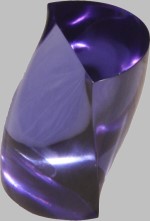A new fundamental geometric shape with a relationship to Phi.
Here’s a challenge to “all the real mathematicians in the back row,” as my college professor often said:
- Picture the classic solids of geometry, each sitting inside a cube that encloses it on all sides. What is the ratio of surface area of this tangent cube to the surface area of the solid, and which solid results in a ratio that is within 1% of phi?
- Which solid has a silhouette projection from the x, y and z axes of a cube, a sphere and a convex parallelogram?
Give up? Enter the DOR (the Direct Opposite Reverse), at TheDOR.net, a geometric solid discovered by David P. Sterner that is the answer to both of these questions. Sterner sees the DOR as the missing geometric link, a new shape in geometry’s basic set of solids (cubes, cones and cylinders, etc.) that haven’t had a new member since the time of Euclid before 200 B.C.
The patented refractor lens of the DOR creates images that when printed directly to photographic paper create two opposite images, the normal inverse image created by any convex lens but also a positive image of the original subject matter in its true orientation.
The images photographed through the DOR also have an appearance of depth:
You can construct your own 3D model of the DOR using the template below, which is available in a DOR template PDF download.
When constructed, the model has these views:
| Circle / Sphere view | Square / Cube view |
| Third / Convex view | 3D view of all three |
Now picture the various geometric solids sitting inside a tangent cube, that is a cube to which all sides of the solid are touching. The area of the solid to the area of its tangent cube is below, and only the DOR is close to phi, 0.618. Can anyone create a solid as simple in construction but with a tangent cube that is as close to phi, or closer yet? If so, contact David Sterner with your discovery.
| Solid | Solid Image | Surface Area Formula of Solid | Ratio of Surface Area of Solid to its Tangent Cube |
| DOR | 0.6086903 | ||
| Cone | pr² + p( r x s )wheres = √( r² + h² ) | 0.4236003… | |
| Dodecahedron | 3a² Ö(25+10Ö5)where a = length of an edge, with a width of two times phi and edge of 2/phi. | 0.50202854 | |
| Pyramid | |
(½ x P x s ) + A where A = area of the base shape P = perimeter of base shape s = height of face triangles |
0.5393446… |
| Sphere | 4pr² | 0.5235987… | |
| Cylinder | 2pr² + 2prh | 0.7853981… | |
| Prism | 2A + Pdwhere A = area of the base shape P = perimeter of base shape d = height of prism |
1.0000000 |
